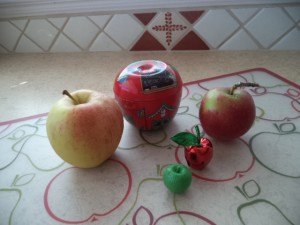Did you know that comparing sizes is a complicated thinking skill? It’s a great deal more than learning the words big and little and requires considerable brain connections.
Size is all about relationships instead of being about the bigness or smallness of something. A riding car is pretty small compared with a real car, but it’s pretty big compared to a matchbox car.
The riding car hasn’t changed its size, it stays the same, but it can still be big or small at the same time. No wonder the brain has a challenge figuring out sizes. Young children need lots of experience with using the words for sizes and with comparing objects.
 When cutting up apples for a snack, I asked if the kids wanted big ones or small ones. Of course, they wanted big ones. I then showed them that the small apple was big when compared to a really small toy apple. We teased and played with some other apples making lots of different big and small ones.
When cutting up apples for a snack, I asked if the kids wanted big ones or small ones. Of course, they wanted big ones. I then showed them that the small apple was big when compared to a really small toy apple. We teased and played with some other apples making lots of different big and small ones.
Big Sister understood more and was more capable of accurate comparisons than Little Sister. Big Sister is big when she stands by Little Sister, but she is little when she stands by me.
 This apple puzzle uses sizes to make a sequence. Other toys can be used to give children an opportunity to explore sizes. So can the measuring cups and spoons in the drawer or even the shoes at the door.
This apple puzzle uses sizes to make a sequence. Other toys can be used to give children an opportunity to explore sizes. So can the measuring cups and spoons in the drawer or even the shoes at the door.
As with other strategies and skills, kids need lots of hands-on experiences to figure out sizes. With kids, maybe we could say that big learning comes in a small size?
